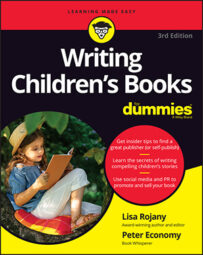Before you can start writing funny children’s books, you need to understand the kinds of things that kids tend to consider funny. And although there may seem to be no rhyme or reason for exactly what children find humorous, research shows that children go through different stages of humor development.
According to humor researcher (no, we didn’t make that up) Paul E. McGhee, Ph.D., you can expect the following developmental changes in preschool children’s humor:
Stage 0 (Age 0 to 6 months): Laughs, no humor. During the first six months of life, children laugh not because they find something funny, but because something physically arouses them — like bouncing the little tykes on your knee or tickling them.
To tickle this age group’s fancy, write your story in a way that requires the actual reader (parent, sibling, or care provider) to do something funny, like read in a funny voice or make unexpected physical movements or gestures. The content doesn’t matter — how it’s presented does.
Stage 1 (Age 6 to 12 months or so): Laughs with or at parent or caregiver. During this period, children begin to find humor in the behavior of a parent or other significant people in their lives.
Making silly faces or odd sounds can get a laugh from kids in this age bracket, as will a funny game of peek-a-boo. Write these kinds of actions into your story so that the parent or caregiver can act them out.
Stage 2 (Age 12 months or so up to 5 years): Pretends that a particular object is something it’s not. If you’ve ever seen a child sit in a big, cardboard box, making noises like a gasoline engine or inviting her favorite dolls to an elaborate tea party, or turning a folded-up piece of paper into a jet airplane, then you’ve witnessed the power of pretend.
Use the power of pretend in your stories to tap into this source of humor.
Stage 3a (2 to 3 or 4 years): Plays with the names of common objects or actions. At this age, as language skills improve, kids begin to find humor in misnaming common objects. You can plumb this source of humor by calling a shoe a boat, turning a dog into a cat, a father into a mother, and so forth.
Stage 3b (2 to 3 or 4 years): Misnames with opposites. This form of misnaming — particularly attractive to many children — involves stating the exact opposite of a particular word. Cold is hot, up is down, over is under, fast is slow, wet is dry. Every adjective has an opposite—consider the possibilities!
Stage 4a (3 to 5 years): Plays with the sounds of words. At about three years of age, children begin to play not just with word meanings, but with their sounds. A common word such as turkey springs forth any number of variations including lurky, wurky, perky, and so on.
Children alter words for the humor of doing so and begin to create their own nonsense words to be funny. Use word sounds to create humor in your story.
Stage 4b (3 to 5 years): Uses nonsense word combinations. Most three-year-olds also begin to put real words together in combinations that make no sense. Examples of these kinds of humorous combinations include “I want some monkey juice” or “Give me that mushroom spoon.” What nonsense word combinations can you insert into your story?
Stage 4c (3 to 5 years): Distorts features. As children increase their command over the real names of objects, people, or animals, they find humor in distorting some aspect of them.
They do this by adding features that don’t belong (putting a fish’s head on a dog’s body), by removing features that do belong (a house with no doors), by changing the shape, size, location, color, and length of familiar things (a person with a grapefruit head), and by ascribing impossible behavior to people or animals (a cat that talks).
Pre-riddle stage (5 to 7 years or so): Discovers riddles and jokes. Sometime during this period, most kids discover the joy of jokes and riddles, and the verbal humor shared by older children around them. The ubiquitous knock-knock joke is an example of this kind of humor. (“Knock knock.” “Who’s there?” “Orange.” “Orange who?” “Orange you glad I didn’t say ‘knock knock’ again?”)
If, however, you want to aim your writing more toward older kids, it helps to understand their unique sense of humor. Children in early elementary grades love broad physical humor, such as pie in the face, pants falling down to expose underwear, slipping on a banana peel, and so on.
William Kotzwinkle and Glenn Murray’s Walter the Farting Dog (North Atlantic Books) is the perfect example of poo-poo humor in a picture book. It’s especially funny if a “serious” character (such as a parent or teacher) unwittingly does these things.
Witness the popularity of the Captain Underpants chapter books for ages 7 to 10 by Dav Pilkey (Blue Sky Press/Scholastic). From about second grade on, kids begin to appreciate verbal humor (witty banter, sarcasm, irony, and so on in dialogue) and have the patience to allow a joke to be set up over several scenes.
As you get more experienced incorporating humor in your writing, you can try branching out beyond specific humor stages. Tons of books achieve many levels of humor, thus appealing to many different ages — even adults enjoy reading them again and again (imagine that!). Dr. Seuss books fall into this category.

